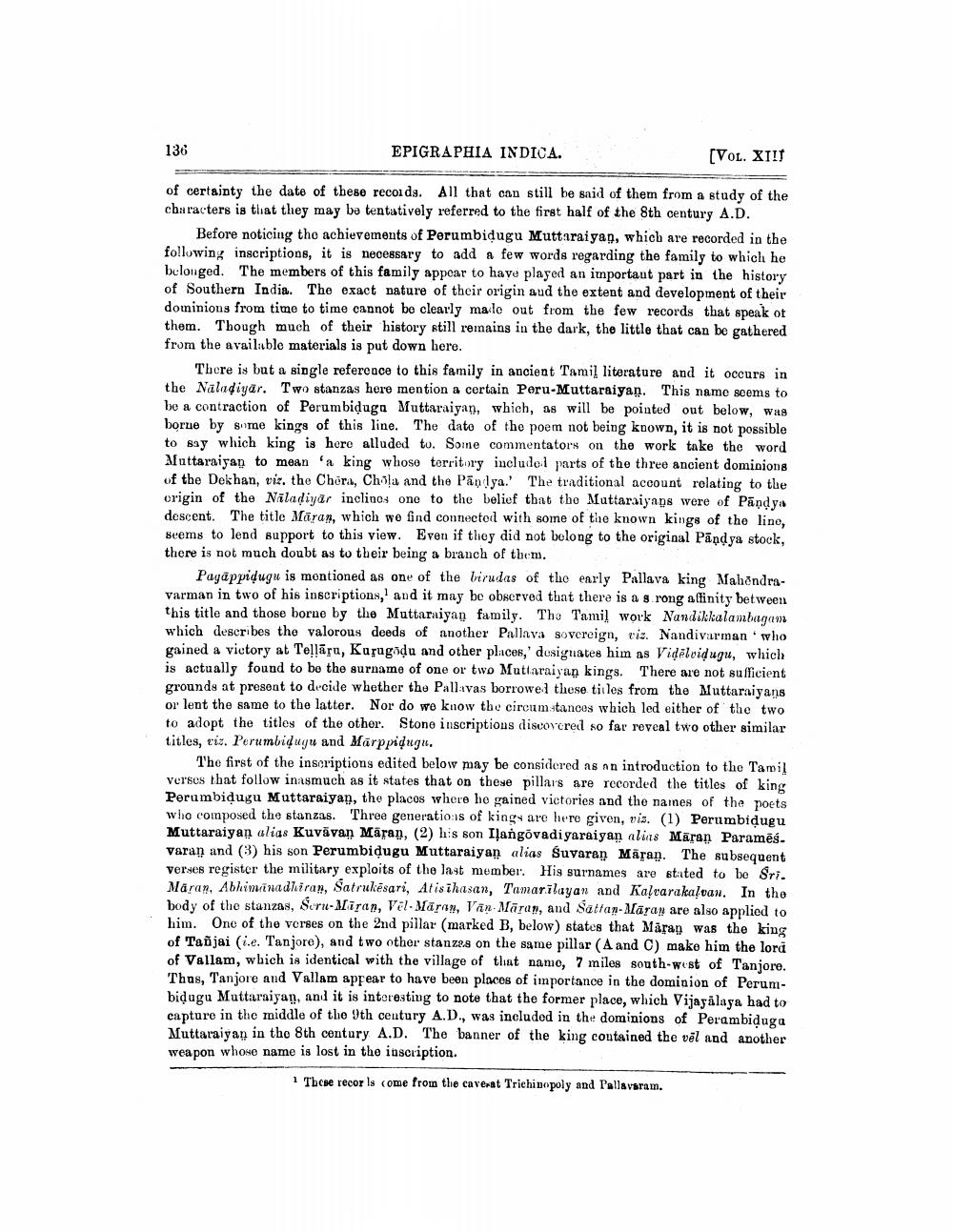________________
136
EPIGRAPHIA INDICA.
(VOL. XI!
of certainty the date of these records. All that can still be said of them from a study of the characters is that they may be tentatively referred to the first half of the 8th century A.D.
Before noticing the achievements of Perumbidugu Muttaraiyan, which are recorded in the following inscriptions, it is necessary to add a few words regarding the family to which he belonged. The members of this family appear to have played an important part in the history of Southern India. The exact nature of their origin aud the extent and development of their dominions from time to time cannot be clearly male out from the few records that speak ot them. Though much of their history still remains in the dark, the little that can be gathered from the available materials is put down here.
There is but a single reference to this family in ancient Tamil literature and it occurs in the Naladiyar. Two stanzas here mention a certain Peru-Muttaraiyan. This name seems to be a contraction of Perumbiduga Muttaraiyan, which, as will be pointed out below, was borue by some kings of this line. The date of the poem not being known, it is not possible to say which king is here alluded to. Some commentators on the work take the word Muttaraiyan to mean 'a king whoso territory includel parts of the three ancient dominions of the Dekhan, viz. the Chora, Chola and the Pānilya.' The traditional account relating to the origin of the Naladiyar inclines one to the belief that the Muttaraiyans were of Pandy descent. The title Māran, which we find connected with some of the known kings of the line, seems to lend support to this view. Even if they did not belong to the original Pāņd ya stock, there is not much doubt as to their being a branch of them.
Pagāppidugu is mentioned as one of the birudas of the early Pallava king Mahendravarman in two of his inscriptions, and it may be observed that there is a g rong affinity between this title and those borne by the Muttaraiyan family. The Tamil work Nandikkalambagan which describes the valorous deeds of another Pallava sovereign, ris. Nandivarman who gained a victory at Telāra, Karugadu and other places,' designates him as Vidaloidugu, which is actually found to be the surname of one or two Muttaraiyan kings. There are not sufficient grounds at present to decide whether the Pallavas borrowed these tiiles from the Muttaraiyans or lent the same to the latter. Nor do we know the circumstances which led either of the two to adopt the titles of the other. Stone inscriptious discovered so far reveal two other similar titles, viz. Perumbiduyu and Mārppiduga.
The first of the inscriptions edited below may be considered as an introduction to the Tamil verses that follow inasmuch as it states that on these pillar's are recorded the titles of king Perambidugu Muttaraiyan, the placos where he gained victories and the names of the poets who composed the stanzas. Three generatio:s of kings are here given, vis. (1) Perumbidugu Muttaraiyan alias Kuvāvan Māraŋ, (2) his son Iļangovadiyaraiyan alins Maran Paramēś. Varan and (3) his son Perumbidugu Muttaraiyan alias Suvaran Märan. The subsequent verses register the military exploits of the last member. His surnames are stated to be Sri. Märan, Abhimiwadhira, Satrukësari, Atis ihasan, Tamarilayan and Kalvarakalvan. In the body of the stanzas, Soru-Miran, Vel. Mary, Van. Märan, and Satran-Māray are also applied to him. One of the verses on the 2nd pillar (marked B, below) states that Maran was the king of Tañjai (ie. Tanjore), and two other stanzes on the same pillar (A and C) make him the lord of Vallam, which is identical with the village of that namo, 7 miles south-west of Tanjore. Thus, Tanjore and Vallam appear to have been places of importance in the dominion of Perumbidugu Muttaraiyay, and it is interesting to note that the former place, which Vijayalaya had to capture in the middle of the 9th century A.D., was included in the dominions of Perambiduga Muttaraiyan in the 8th century A.D. The banner of the king contained the vēl and another weapon whose name is lost in the inscription.
1 These recor Is come from the caverat Trichinopoly and Pallavaram.




